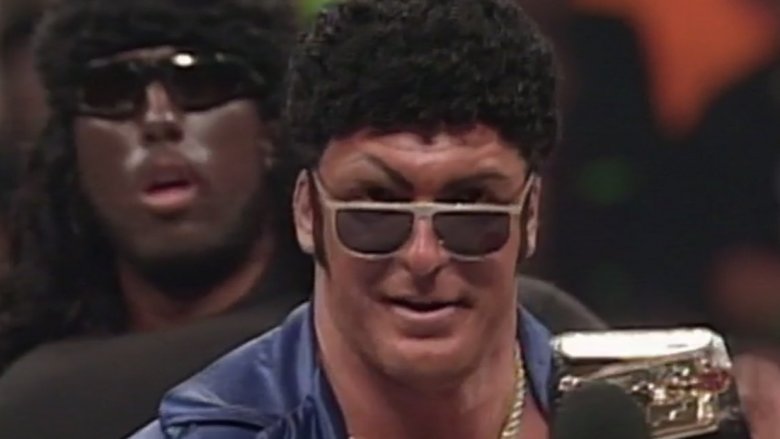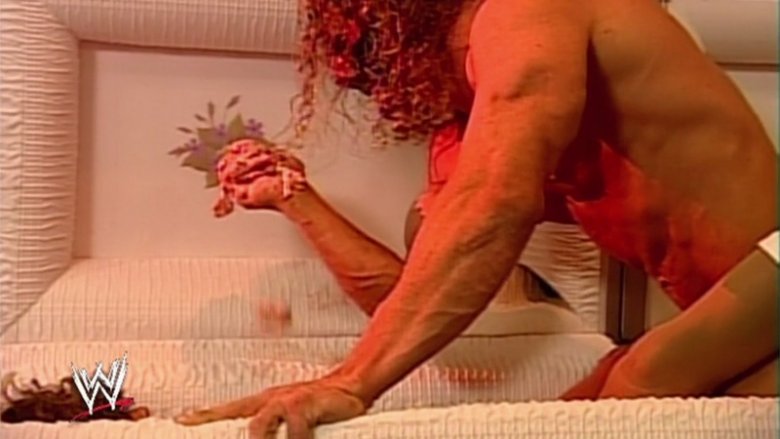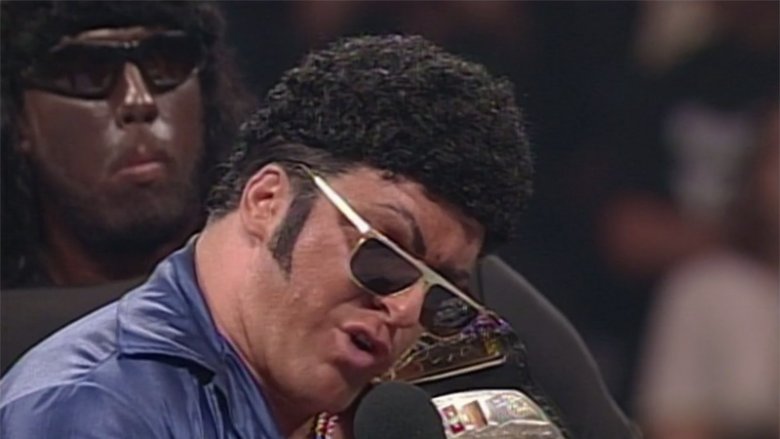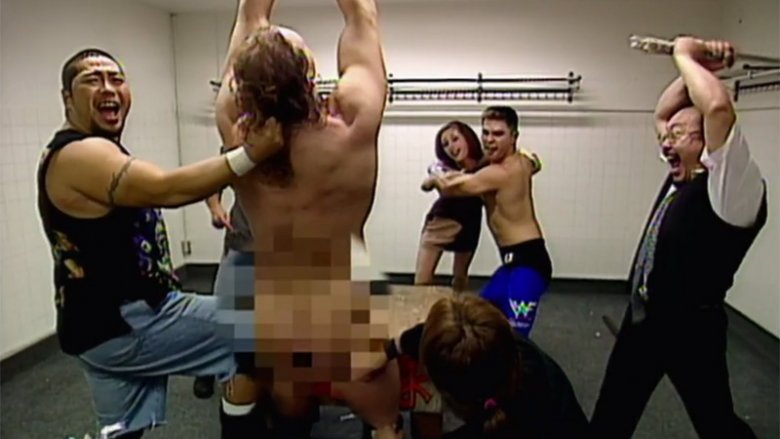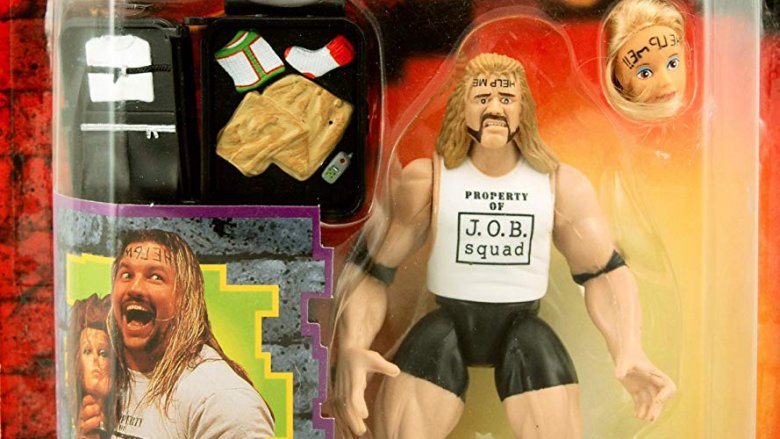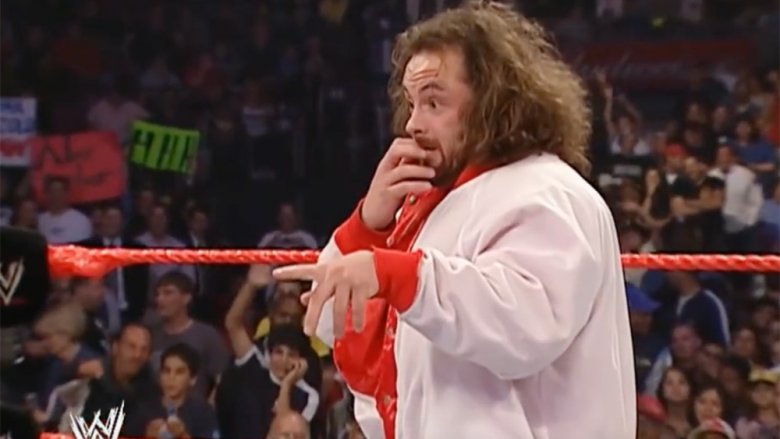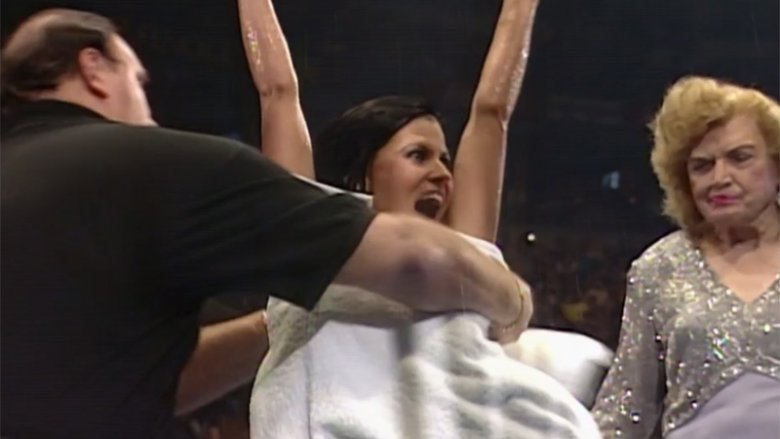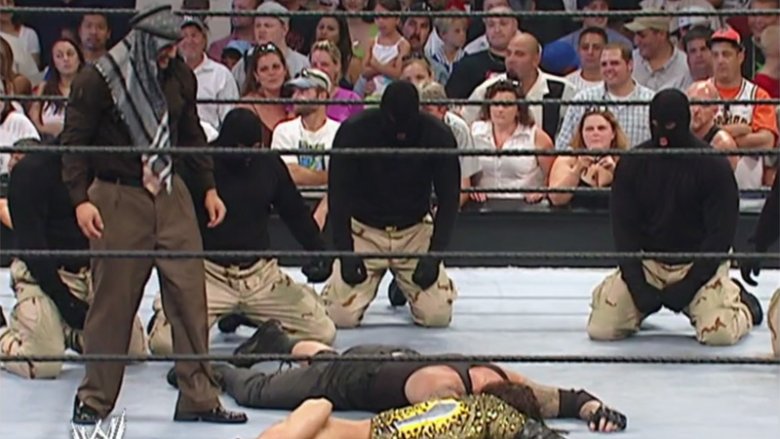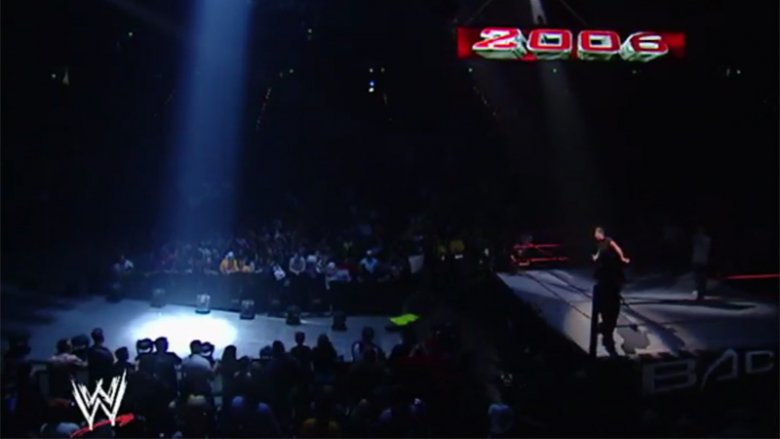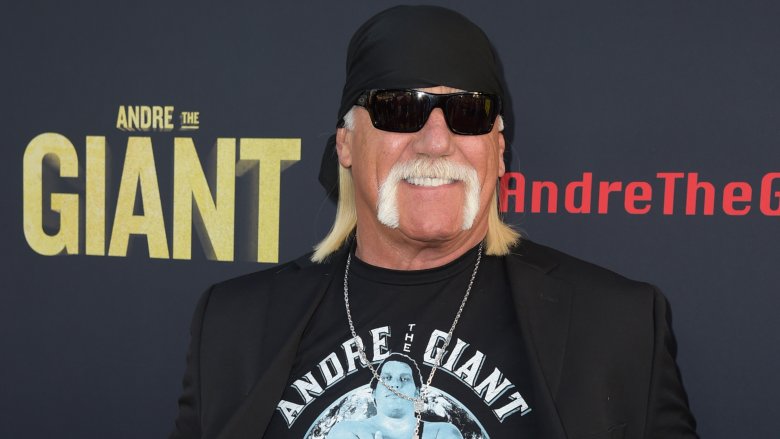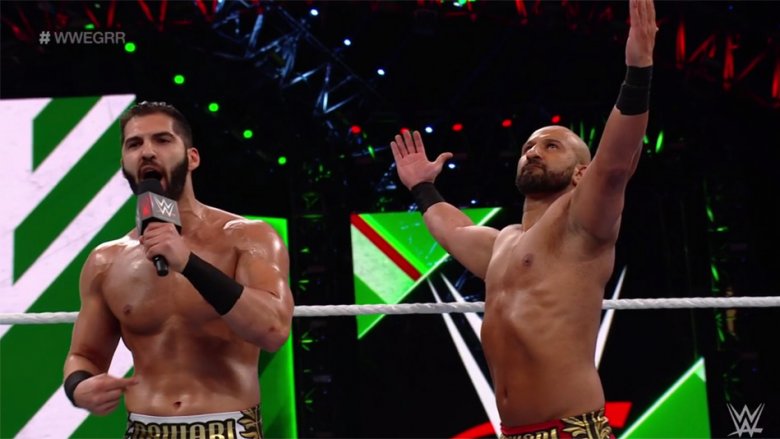The Most Controversial Things WWE Has Ever Done
With its over-the-top characters and larger-than-life brawls, the world of pro wrestling is built on spectacle, pomp, and circumstance. And that's exactly how fans love it. Sometimes, though, that spectacle goes a little too far. In the past, World Wrestling Entertainment has had to deal with accusations of creating content that's racist, sexist, demeaning, or otherwise offensive, and looking back at WWE's history, it's easy to see those accusations aren't exactly unfounded — it's been a ... colorful and eventful run, to say the least.
A little controversy can be a good way to grab headlines and get attention for the product, but as these examples show, there are plenty of moments that have gone too far. Here are the most controversial things the WWE has ever done or been party to.
Katie Vick's funeral had way too much lovin'
In the late '90s and early 2000s, the World Wrestling Federation kicked off a period that fans remember today as the Attitude Era. This was the time when anti-heroes like Stone Cold Steve Austin and the Rock became household names, and when the on-screen storylines were pushing the envelope in every conceivable way and arguably crossing the line into offensive. When Triple H kicked off a feud with Kane in 2002, there was nothing arguable about how offensive things got. The infamous Katie Vick storyline isn't just tasteless, it's probably the single most tasteless thing that's ever been aired on WWE television.
The basic idea was that Triple H had uncovered a shameful secret about Kane's past: a drunk driving accident that had resulted in the death of his high school girlfriend, Katie Vick. It was a weird bit of realism for a character that, up to that point, had been the supernaturally tough, demonic brother of an undead cowboy and occasional Lord of Darkness. Kane's backstory would become infinitely more complicated to the point of having an entire novel written about it as the years went by, but at the time, it was difficult to imagine the character even going to high school, let alone to a party that involved the sinister scourge of underage drinking. Either way, the insinuation that Kane was a murderer was just the tip of the iceberg. On the October 22, 2002, episode of Monday Night Raw, Triple H promised to present "the most graphic and salacious video footage" he'd ever seen, and definitely delivered on that front.
The footage involved Triple H himself, in a Kane mask, providing a "re-enactment" of Katie's funeral, complete with a mannequin in a cheerleader uniform in a coffin. Over the course of seven seemingly eternal minutes, Triple H groped the mannequin, then climbed into the coffin himself, and simulating a sex act that ended when he produced a handful of raw meat to prove he'd literally "screwed her brains out." WWE's modern, TV-PG attempts at being kid-friendly might have its problems, but at least we don't have to worry about this kind of thing anymore.
DX does blackface
One of the more positive aspects of the Attitude Era is that it often involved competing factions, giving wrestlers a way to contribute to major storylines regardless of their position on the card. Unfortunately, the factions were often built around racial stereotypes, especially during the "Gang Warz" storylines that revolved around a skinhead biker gang called the Disciples of the Apocalypse, the Puerto Rican Los Boricuas, and the Nation of Domination, a cartoonish parody of the Nation of Islam and the Black Panthers. Also, there was a South African militia called the Truth Commission, but that one wasn't really racially motivated. It was just weird.
Either way, the Nation wound up feuding with D-Generation X, a faction led by Triple H that was known for over-the-top antics like driving military vehicles up to a show put on by rival promotion WCW. On July 6, 1998, DX's latest bit of dubious comedy involved coming to the ring in costume as the Nation. That in itself isn't surprising, since dressing up as your opponent had been a time-honored heel tactic for years, but if you were paying attention to the last paragraph, you might've already spotted the problem here. The Nation was mostly made up of black wrestlers. DX was entirely composed of white dudes.
The result? DX's costumes involved using makeup to darken their faces, and while most of them weren't quite as noticeable back in the days of Standard Definition, X-Pac — who parodied Mark Henry as "Mizark" — hit the ring in full-on Minstrel Show blackface. Despite the crowd's shockingly positive reaction, the skit was monumentally offensive at the time and certainly hasn't aged well in the 20 years since. It is, however, still included on many official releases from WWE that tout it as a high point for comedy, although it's also worth noting that X-Pac himself has since expressed his regret about it.
Val Venis gets castrated
Back in 1998, the WWF introduced their audiences to the latest in a long line of characters who seemed to have taken up professional wrestling as their second careers, like the Big Boss Man (a wrestling prison guard), IRS (a wrestling accountant), and of course, the Undertaker (a wrestling undertaker). This time around, it was Val Venis, a wrestling adult film star. Please note that this is not the controversial part.
That came (so to speak) when Venis got into a feud with Kai En Tai, a faction of Japanese wrestlers, during which he filmed a sex tape with Kai En Tai's manager Yamaguchi-San's wife. While this is normally the sort of thing that would be settled in a match, Yamaguchi-San opted to go for a more brutal form of revenge by waving around a sword and threatening to, and this is a quote, "choppy choppy your pee pee." Sure enough, on the August 3, 1998, episode of Raw, the members of Kai En Tai ambushed Val after a match, dragged him backstage, and tied him up with his junk on a literal chopping block.
The show went off the air just as Yamaguchi-San, screaming, brought his katana down to emasculate Val, but the next episode revealed that a sudden gust of cold air had allowed him to, ah, contract his way out of danger.
Al Snow and the 'severed head'
Not all of the negative press that WWE got back in the Attitude Era was based on something they actually did. The company definitely courted controversy, but in 1999, they made headlines based entirely on concerned parents completely misunderstanding a gimmick — maybe intentionally.
The problem centered on Al Snow, whose onscreen persona was, to put it lightly, a little disturbed. Snow was known for carrying around a mannequin head named Head that he would frequently have one-sided conversations with. Mostly, this resulted in jokes about how "everybody wants Head," and neither Snow nor WWE ever presented it as anything but what it was: a mannequin head that Snow had picked up at a discount store back when he was working in Extreme Championship Wrestling that was used as a prop for his relatively lighthearted, "crazy" character.
When his action figure hit Walmart, however, a customer who saw it out of context — and apparently had no familiarity with the show — wrote a letter to the Atlanta Journal-Constitution decrying it as "a training manual for spousal abuse." The story quickly hit national news, and Walmart banned the action figure from its shelves. As Snow himself would later say, "You can still buy an AR-15, live ammo, and a hunting knife at Walmart, but you can't buy Pregnant Barbie or my action figure."
Eugene
Most controversies in WWE history are based on things the characters do. In the case of Eugene, however, it was the character itself that was offensive: a mentally disabled wrestler who was usually played for laughs.
Introduced in 2005 — yes, 2005, this century — Eugene was played by Nick Dinsmore, an extremely talented but largely unknown journeyman wrestler. The idea was that he was the onscreen nephew of the evil Eric Bischoff, whose obsession with wrestling had made him a sort of "wrestling savant," who could emulate his heroes once the bell rang and whose obvious mental difficulties would immediately make him sympathetic to the crowd.
Unfortunately, Dinsmore's portrayal of Eugene was at best a thoughtless caricature. In addition to his physical appearance, which included wild, unkempt hair, his wrists locked into an angle that parodied cerebral palsy, and exaggerated wide-eyed nodding whenever he got excited, Eugene also came to the ring in a jacket that was worn inside-out and buttoned incorrectly, accompanied by an entrance video that boasted his name in childlike scrawl. WWE kept Eugene around for years, and the character never got any better.
Increasingly indecent exposure
Calling pretty much everything WWE did with their Women's Division from the mid-'90s to about 2010 "controversial" is the most polite way to put it, but December 12, 1999, marked a definite low point. At the Armageddon pay-per-view event, the Women's Championship was defended in a match between four competitors who had to win by stripping each other out of evening gowns. Also, the match took place in a pool rather than in the ring, and was won by the Kat, who had never trained as a wrestler, and who quickly overshadowed any in-ring — er, in-pool action by whipping off her bra in the first-ever instance of the company featuring intentional nudity on television.
The next month, they attempted to push the envelope even further. 2000's Royal Rumble featured the first (and only) "Miss Rumble" bikini contest. Anyone hoping for a repeat performance of Armageddon should've probably worded their wish a little more carefully. One of the women involved did in fact take her top off, but it wasn't the Kat, whose bikini was literally made of packing tape and bubble wrap. Instead, it was 76-year-old Mae Young, and while it would later be revealed to be a flesh-colored prosthetic rather than her actual aged physique, it was convincing enough for the audience at home.
The problems with this particular incident went beyond the viewing audience and actually hurt WWE in the international market. At the time, WWE had recently struck a deal with Channel 4 that saw their pay-per-view events becoming available to virtually everyone in Great Britain who owned a TV. The first event they aired was, of course, Royal Rumble 2000. Thanks to Mae Young's bikini contest victory and a particularly bloody match between Cactus Jack and Triple H, the next one was aired on a delay and heavily edited, and Channel 4 didn't renew the deal when it was up.
Muhammad Hassan terrorizes the Undertaker
In late 2004, a character named Muhammad Hassan debuted in WWE, with the premise being that he was an Arab-American wrestler who was tired of being stereotyped as a "terrorist" because of his race. Given the political climate of the time, that seems like a reasonable complaint, but Hassan was portrayed as a bad guy, and WWE was more than happy to lean into the terrorist imagery.
It hit its peak in July 2005 when Hassan and his manager, Daivari, were embroiled in a feud with the Undertaker, who — rather than being a spooky undead cowboy or a sinister Lord of Darkness — was in the "American Badass" phase of his career. After 'Taker beat Daivari in a match, Hassan dropped to his knees and extended his arms as though praying, and five men in ski masks and desert camo hit the ring to beat the Undertaker down and choke him with a garotte wire before kneeling in a semicircle as Hassan locked on a submission hold called the Camel Clutch.
If all that sounds tasteless, brace yourself, because this one actually gets worse. While the episode of SmackDown on which all this happened was taped on July 4, it actually aired on July 7, 2005 — the same day that the news was dominated by news of a terrorist attack in London that killed 52 people. The news media took notice, and while WWE initially attempted to spin it to give the Hassan character more material to work with, UPN, SmackDown's home network, pressuring WWE to remove the character from the show. The feud with the Undertaker and Hassan's career with WWE were both finished in an eight-minute match a few weeks later.
Vince McMahon gets a win against God
Going into the 2006 Backlash event, Vince McMahon was feuding with Shawn Michaels. In real life, Michaels had become a born-again Christian a few years earlier and incorporated his beliefs into his onscreen persona as well. Usually, this came in the form of adding crosses to his ring gear and very visibly praying during his entrances, but when he signed on for a match against Vince and his son Shane, Michaels was a part of one of wrestling's most jaw-dropping moments, when he was assigned his tag team partner: God.
The Internet Wrestling Database defines this one as a handicap match between Michaels and his two opponents, but the listing on the WWE Network assures viewers that the McMahons were facing the team of "Shawn Michaels and God." In this case, the Almighty's presence was represented by a spotlight that moved down the entrance ramp to the ring while Vince berated and mocked God before telling the referee to check him for hidden weapons and then assuring Michaels that in the match that followed, "you and God are gonna go straight to Hell!"
It's worth noting that McMahon was absolutely the bad guy in this story, and this villainous behavior was presented as just that. With that in mind, it probably wouldn't have been that bad if Michaels had actually won the match, especially given that he's usually regarded as one of the greatest in-ring performers of all time, and could pretty believably beat up a 61-year-old CEO and his non-wrestler son without actually requiring divine intervention. Instead, Vince won the match by pinning Michaels. The storyline would continue and Vince would get his eventual comeuppance, but plenty of viewers found the "Mr. McMahon" character having a canonical victory over "God" to be pretty tasteless.
Hulk Hogan's Hall of Fame 'suspension'
Hulk Hogan is one of the most well-known wrestlers in the world, a truly iconic figure who took pro wrestling to new heights twice in two different decades. He's also someone who was caught on tape using incredibly offensive racial slurs. When that came out in 2015, WWE quickly moved to get some distance from Hogan, eliminating him from the most recent version of their Tough Enough reality show competition and removing him from the WWE Hall of Fame.
Before long, however, there were rumors that Hogan and WWE would reach an agreement to see him restored to his previous status, and sure enough, they announced on July 15, 2018, that Hogan was being reinstated after a "three-year suspension," which was the first time it had ever been referred to as a suspension rather than a permanent removal.
Needless to say, this prompted a debate among fans and fellow wrestlers that touched on questions about forgiveness and redemption that aren't usually seen inside the squared circle, with plenty of black wrestlers asked for comment. Kofi Kingston touched on those issues in a statement on Twitter, saying "from a career standpoint, there is no argument on whether or not Hogan should have his place" and fellow Hall of Famer Mark Henry said he believed Hogan was "willing to fix it."
The Greatest Royal Rumble prompted death threats
A heel wrestler insulting a location as being inferior to their own hometown is a time-honored tradition in pro wrestling, but in 2018, WWE discovered that the politics of the Middle East are a little more complicated than the rivalry between, say, Boston and New York.
At a show called the Greatest Royal Rumble that was broadcast live from Saudi Arabia — a show that had already raised some controversy with the news that women would not be allowed to perform at the event — the company decided to rely on this time-honored tactic. To that end, Ariya and Shawn Daivari, two Iranian-American wrestlers from Minneapolis, came out to run down Saudi Arabia and announce that "Real athletes, like the Daivari brothers, come from the strongest nation in the world: Iran!" As you might expect, they were quickly beaten up by local talent in the form of four Saudi Arabian wrestlers that had been selected from a tryout WWE had held earlier that week.
While the crowd at the show seemed pretty into it, the same could not be said of everyone. After the segment, the Daivari Brothers got death threats and even took to Twitter to clarify that they were speaking in character and that the long-running, complicated, and conflicted history of the two nations was not meant to be solved in the wrestling ring. With another international spectacle already on the schedule, the Greatest Royal Rumble definitely won't be the last WWE show from Saudi Arabia, but maybe next time, they can avoid going for the cheap heat.
